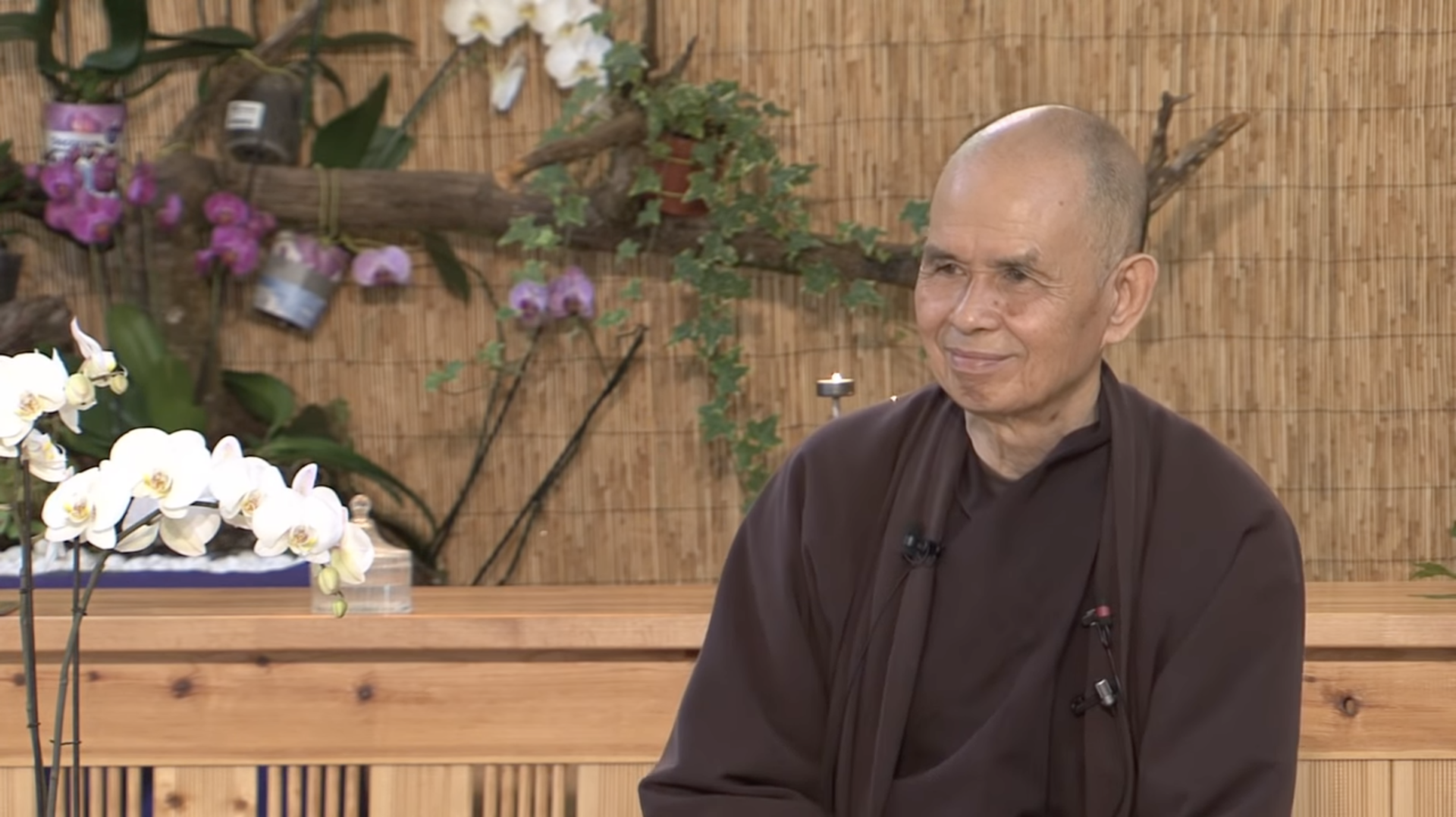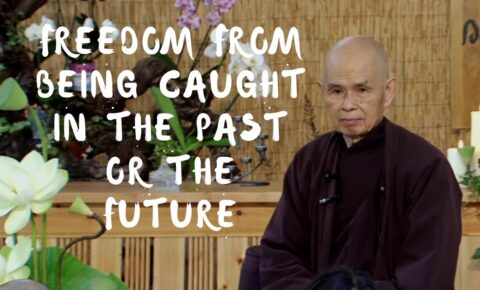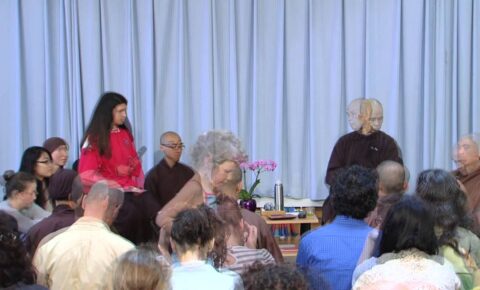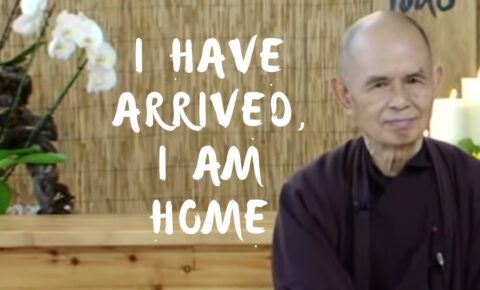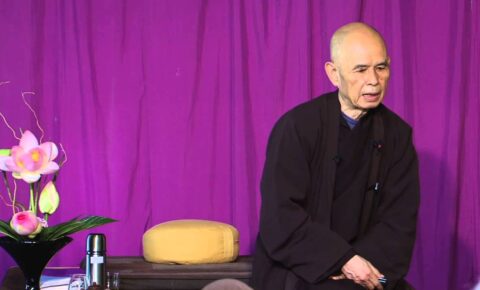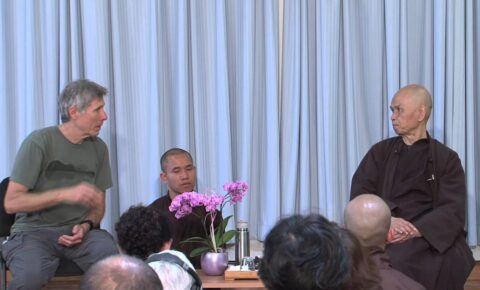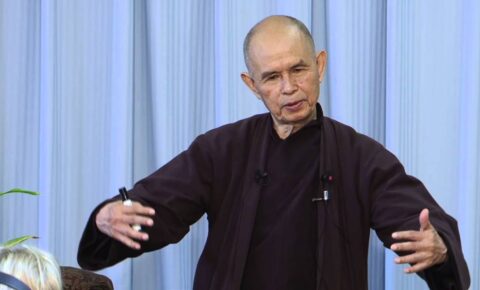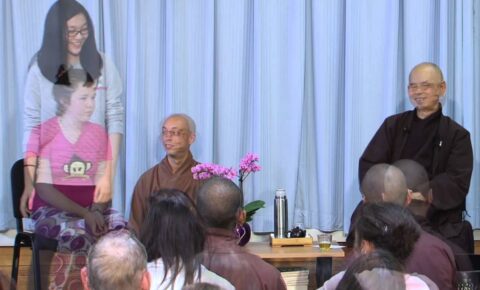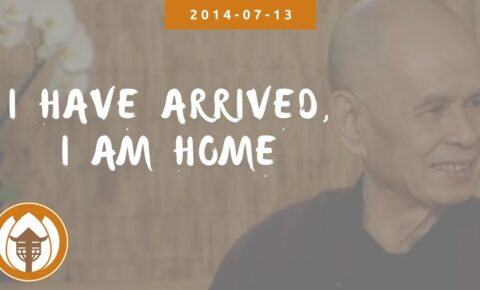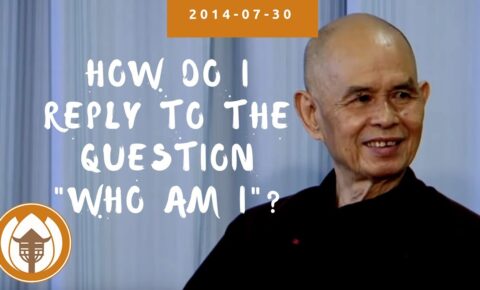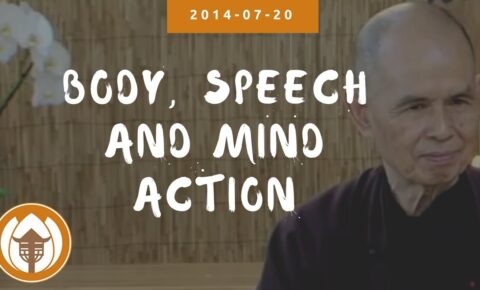From the Assembly of Stars Meditation Hall at Lower Hamlet, Plum Village. This is the first dharma talk of the annual Summer Opening retreat at Plum Village. This short 37-minute talk is in English with a focus on the three energies of practice – mindfulness, concentration, and insight. Both the audio and the video are available below.
Mindfulness is a kind of energy that we can generate. Everyone has the capacity to generate the energy of mindfulness and allows us to be aware of what is going on in our body, in our feelings, in our perceptions, and in the world around us. What is happening in the here and the now. The world around us the object of our mind. If we are not in the here and the now then we cannot know what is happening in the present moment. We have an appointment with life. We may have been running and looking for something elsewhere and we will miss our appointment with life.
Mindfulness is always mindfulness of something. For example, drinking our tea. When you are very aware of something, you are concentrated on something and you begin to see something deeply. Therefore, mindfulness contains concentration. Can we see the nature of no birth and no death in our tea? Mindfulness also carries the energy of insight. What are the three energies? Mindfulness. Concentration. Insight. We can all generate these energies, right from the beginning of our practice. With these three kinds of energies, we can do many things. For example, we can generate a feeling of joy and a feeling of happiness.
How do we live deeply every moment of our daily life? How do we see our conditions of happiness? How do we make use of our suffering?
Good morning, dear Sangha.
Welcome to the Summer Opening in Plum Village. Today is the 6th of July, 2014 and we are in the Assembly of Stars meditation hall in the Lower Hamlet, Plum Village.
Mindfulness is a kind of energy that we can generate. Everyone has the capacity to generate the energy of mindfulness. That energy allows us to be aware of what is going on. Going on in our body, going on in our feelings, going on in our perceptions, in our mind, and going on around us, in the world. So mindfulness, you can define it as the kind of energy that allows us to be aware of what is happening in the here and the now. In our body, in our feelings, in our mind, and in the world, which is the object of our mind.
In the Buddhist tradition we always try to remember that the world is the object of our mind. Our mind and the world form perception, subject of perception and object of perception. And mindfulness is the kind of energy that allows us to be in the here and the now. If you are not in the here and the now you cannot know what is happening in the here and the now. So mindfulness is also the capacity to help us to be established in the here and the now. And we know that life and all the wonders of life are available only in the here and the now. And mindfulness helps us to go home to the here and the now and get in touch with life, with the wonders of life that are available in the here and the now. It’s so simple. So we have an appointment with life. J’avais un rendez-vous avec la vie. And that appointment takes place in the present moment. And if you miss the present moment, you miss your appointment with life, which is very serious. So next time when someone asks you whether you have time, you may say I have an appointment, and with whom? With life. I don’t want to miss that appointment with life, that is why I always try to be home in the here and the now. In the here and the now I get in touch with nature, with the refreshing and healing elements of nature that are in me and around me. Because I need nourishment and healing. So I have to go home to the here and the now in order to get the nourishment and healing that I need, because I have been running all my life looking for something in the future, elsewhere, and I have missed my appointment with life. Because of that I have become sick. I suffer, that is why I have to learn to go home to the here and the now and get in touch with the elements of life that can be healing and nourishing. And mindfulness helps me to go home to the here and the now and get in touch with the wonders of life.
Mindfulness is always mindfulness of something. When you drink you tea, and if you are aware that you are alive and you are drinking your tea, that is mindfulness of drinking. And you might choose to drink your tea always in mindfulness, if you want. Because drinking like that, you are very alive. You are living deeply that moment of life given to you to live. So I like to make a commitment to drink my tea mindfully. And when I drink my tea mindfully, I am concentrated in my tea. So the energy of mindfulness carries within itself the energy of concentration. When you are very aware of something, you are concentrated on it. And if you are concentrated you begin to see things deeply. Suppose I hold my cup mindfully. And because I am holding my cup mindfully I am truly here and established in the present moment. And suppose I pour the hot water in my pot In my teapot mindfully I have concentration, and that concentration allows me to see many things.
I see that this water has come from deep up in the mountain, deep in the earth. It has come to me in this bottle And as I pour the tea mindfully, with concentration, I can see many things that people who are not mindful cannot see. I can see that there is a cloud in my tea. Yesterday it was a cloud floating in the sky. Now it is the tea. And that is why when I drink my tea, I see that I am drinking my cloud, and the cloud has not died, even if it is no longer in the sky, but it has not died, because it is here, in it’s new form of manifestation. I can listen to my tea, to my cloud. And if my concentration is very strong I can discover the nature of no birth and no death of my cloud. I know that it is impossible for a cloud to die, because to die means from someone you suddenly become noone, from something you suddenly become nothing, and that is what we mean by dying. But if I am mindful, concentrated, I’d be full of insight. I can see that my cloud can never die. It can become snow or rain or ice, but it can never become nothing. So I touch the nature of no birth and no death of the cloud. And if I continue, I can see myself having that nature of no birth and no death. If the true nature of the cloud is no birth and no death, then my own nature is the nature of no birth and no death And if I can touch deeply the nature of no birth and no death in me, I am free from fear. Fear of dying, fear of becoming nothing. So mindfulness carries within itself that energy of concentration, and it carries within itself also the energy of insight.
Mindfulness, concentration, insight, that are three kinds of energies that we can generate. And these three kinds of energies have the power to help us suffer less, and help us to generate feelings of joy and happiness. And all of us are capable of generating these three kinds of energies. And to practice meditation, Buddhist meditation, is to generate these three kinds of energies. And everyone can do, and right in the beginning of the practice. You can learn to drink your tea mindfully. You can learn how to walk mindfully. You can learn how to breathe mindfully. And when mindfulness is there, concentration is there, and insight will be there. And with mindfulness, concentration, and insight, I can live very deeply every moment of my daily life. I do not waste my life. I feel alive in every moment. And I will not regret later on that I have wasted my life running after fame, power, wealth, sensual pleasure. Because I feel joy, happiness every moment of my daily life. That is thanks to the power of mindfulness, the power of concentration and insight. So the first energy is mindfulness. It’s written in Chinese like this. The upper part of the word, the character it means now. Now, the present moment. And the later, the lower part is “tâm” and it means mind. When you bring your mind home to the present moment, you are mindful. So mindfulness is to bring your mind back to the present moment. When you begin to breathe in mindfully, you bring your mind home to your body.
The opposite of mindfulness is dispersion, forgetfulness. ‘Thất niệm.” And there are those of us who drink our tea and do not know that we are drinking our tea. There are those of us who walk but do not know that they are walking. Those of us who have a body, all of us have a body, but we forget that we have a body. When you spend two hours with your computer you might forget completely that you have a body. Your mind is caught in the computer, and you leave your body alone. In that moment body and mind are not together. And if body and mind are not together you are truly not alive. You are truly alive only when your mind is with your body. Usually in our daily life our body is there but our mind is elsewhere. Our mind is caught in the suffering concerning the past, or the worries concerning the future, in our projects. And therefore, body one place and mind in another place. In that case there is no mindfulness. And you are not truly alive. You are not truly there in the here and the now. So if you know the practice of mindful breathing you begin to breathe in mindfully.
Breathing in, I know I am breathing in. And it may take two or three seconds for you to breathe in mindfully. And by breathing in mindfully you bring your mind home to your body. And when mind and body are together, you are established in the here and the now. You are fully alive. You are fully present, and that makes true life possible. And sitting, walking, eating, washing, live deeply every moment of your daily life, and you do not waste your life. So mindfulness is the energy that helps us to bring our mind home to our body so that we can be established well in the here and the now and get in touch with the wonders of life that help us to heal and to nourish, to be nourished. “Chánh niệm.” Smrti. And when you are mindful you are concentrated.
“Định” means concentration. Samadhi. They are not two separate energies. If you are mindful, there is some concentration already in here. So we can say that concentration is already there in mindfulness. And when concentration and mindfulness are powerful enough then you can see manifested insight. “Tuệ.” Prajna. So in mindfulness you have concentration and insight. In concentration you have mindfulness and insight. If you look into one you can recognize the two other energies. And Buddhist practitioners they know how to generate these three kinds of energies so that they can be alive. They can be fully alive, fully present in order to live their life deeply. And if you practice for a week the practice of mindful breathing, mindful walking, mindful eating, and then you can notice that the amount of mindfulness, concentration, and insight in you have grown much more stronger. And it is these three kinds of energies that can help us suffer less and help us generate more joy and happiness. With these three kinds of energies we can do many things. With mindfulness, concentration and insight we can generate a feeling of joy and generate a feeling of happiness “Hỷ” and “Lạc”
So the practitioner of Buddhist meditation is capable of generating a feeling of joy or a feeling of happiness whenever she wants to. And with the energy of mindfulness, concentration and insight, a practitioner of Buddhist meditation should be able to bring in a feeling of joy a feeling of happiness whenever we want. And that is done with the energy of mindfulness concentration and insight that we generate with the breathing, with the walking, and so on. And the principle, the mechanism is very simple. How to create a feeling of joy for ourselves, and to be nourished by that feeling of joy. Mindfulness. Mindfulness is born from, ah, joy is born from mindfulness. This is a sentence well known in the Buddhist literature. “Niệm sinh hỷ” Joy born from mindfulness. And joy born from mindfulness, and joy can be born also from concentration, “định” and from insight, “tuệ” The mechanism is simple. When you breathe in mindfully, breathing in I know I am breathing in. I focus my attention on my in-breath. I stop the thinking. I just become aware of my in-breath. My in-breath is the only object of my mind. I focus all my attention on my in-breath. I am concentrated. I allow mindfulness and concentration to be present. And suddenly I discover I’m alive. That is insight. It’s very clear. When you breathe in mindfully you know that you are alive because someone who is already dead does not breathe in anymore. So just breathing in mindfully you get the insight that you are alive. And you know something? To be alive is the most wonderful thing. To be alive. To be still alive is the most wonderful thing. That is the miracle. So breathing in I know I am alive. That is insight born from mindfulness of breathing. I feel I am alive. I have a body and I can get in touch with the many wonders of life like the sunshine, the rain, the vegetation, the flowers, the river, the people. So that kind of awareness, that kind of insight can help you to generate a feeling of joy right away. Joy is born from mindfulness, concentration and insight. When you come home to the here and the now you recognize the fact that there are so many conditions of happiness that are already available. More than enough for you to be joyful and happy.
If you take a piece, a sheet of paper, and try to write down the conditions of happiness that you already have. That is an exercise. Sitting at the foot of the plum tree you write down all the conditions of happiness that you already have. I don’t think that one page is enough. I don’t think that two pages are enough. Three pages are not enough either. You have more conditions to be happy, more than enough conditions in order to be joyful and happy. And mindfulness helps you to recognize these conditions. And happiness can be born right away, joy also. And that is the mechanism of joy and happiness. Mindfulness, awareness of the conditions of happiness that are already available. It’s very clear. Suppose you say you practice, breathing in I am aware of my eyes. So the object of your mind, your mindfulness is your eyes. Breathing in, you focus your attention on your eyes and you discover that your eyes are still in good condition. There are those of us who have lost our eyesight and they cannot see anything anymore. And you are, you still have eyes in good condition. That is a big condition of happiness. Because you have eyes still in good condition you need only to open your eyes and then a paradise of forms and colors become available.
Nature is so beautiful. The stars, the galaxies are so beautiful. Imagine you are an oyster living in the depth of the ocean. You never have a chance to see the stars in the sky and the beautiful waves on the surface of the ocean. Because you have eyes still in good condition, you only need to open them and then the beautiful cosmos is available to you. There is a paradise of forms and colors available in the here and the now. And you can get in touch because you have eyes still in good condition. And your eyes is only one of these conditions of happiness. You will discover thousands and thousands of conditions like that, in your body and around you. The French have a song about this. Qu’es qu’on attend pour etre heureux. Why do you have to wait in order to be happy? You can be happy right now. Qu’es qu’on attend pour faire la fete. There is a lot of wisdom in that song. We can celebrate life. We can make happiness possible right now because the conditions of happiness are more than enough for you to enjoy.
You do not have to run into the future and look for some more conditions of happiness. So that is the mechanism of the practice of joy and happiness. Going home to the here and the now. Recognize the presence of the wonders of life available. Recognize the fact that the Kingdome of God is available in the here and the now. And suddenly joy and happiness are born. That is the art of happiness. You can create joy and happiness using the energy of mindfulness, concentration and insight. You can do it. It takes some training. And that you can learn the habit of being happy, of being joyful. You are so lucky. You are so wealthy and you think that you are poor. You have to go and beg for some happiness elsewhere in the future. Buit in fact, you are very wealthy. You are a treasure of happiness available in the here and the now.
Even the Kingdom of God is available to you in the here and the now. For those of us who practice mindfulness, the Kingdom is available, And if you do not enjoy the Kingdom of God in the here and the now, because you have not made yourself available to the Kingdom. And to make yourself available to the Kingdom, it’s not so difficult. Just breathe in mindfully and bring your mind home to your body and you can recognize the Kingdom of God in every pebble, in every flower, in every child. With mindfulness, concentration and insight, you can touch the Kingdom of God in every moment. And that is the art of happiness using mindfulness, concentration and insight. The other side of the practice is with mindfulness, concentration and insight you can handle suffering. There is anger, fear, despair in you, and if you know how to make good use of mindfulness, concentration and insight you can recognize the pain, the suffering. You can embrace it tenderly. You can allow compassion to be born. And then you suffer less. Right away.
There is a way to suffer. The Buddha knows how to suffer. That is why he suffers very little. And we can learn his art of suffering. If you know how to suffer, you suffer much less. How? With the energy of mindfulness, concentration and insight, you suffer much less than other people. Learn the art of going home to yourself. Recognize the suffering. Embrace it tenderly with mindfulness and concentration and insight and you suffer much less. Especially when you know how to make good use of the collective energy of compassion generated by the sangha. With mindfulness, concentration and insight you suffer less. Much less. And you can even go further. You can make good use of suffering because suffering is useful. It’s like when you grow lotus flowers you need the mud. Without the mud you cannot grow lotus flowers.
If you know how to handle suffering. If you can handle fear, anger, despair. If you know how to make good use of the suffering then you can produce many beautiful lotus of happiness. So a good practitioner is someone who knows how to make good use of suffering in order to create understanding, compassion, and happiness. And that is why we can speak of the goodness of suffering. The usefulness of suffering. It’s like the mud. You should not be afraid of the mud. You know how to make good use of the mud in order to produce beautiful lotuses. So the practictioner does the same. The good practitioner does the same. He knows how to make good use of suffering and create understanding, compassion, transformation, healing, happiness. So on the one hand there is the art of happiness. How to be happy. On the other hand there is the art of suffering. And we learn that if we know how to suffer we suffer much less. And you can make good use of suffering in order to create compassion, understanding, and happiness. And practicing with brothers and sisters in the community you learn from their experience how to do these things.
On one hand, you learn how to produce a feeling of joy and happiness to nourish yourself and help nourish the other person. On the other hand, you learn how to suffer so that you suffer less, and you can create happiness out of your suffering. We continue tomorrow in French.
You can help us caption and transcribe this video on Amara
